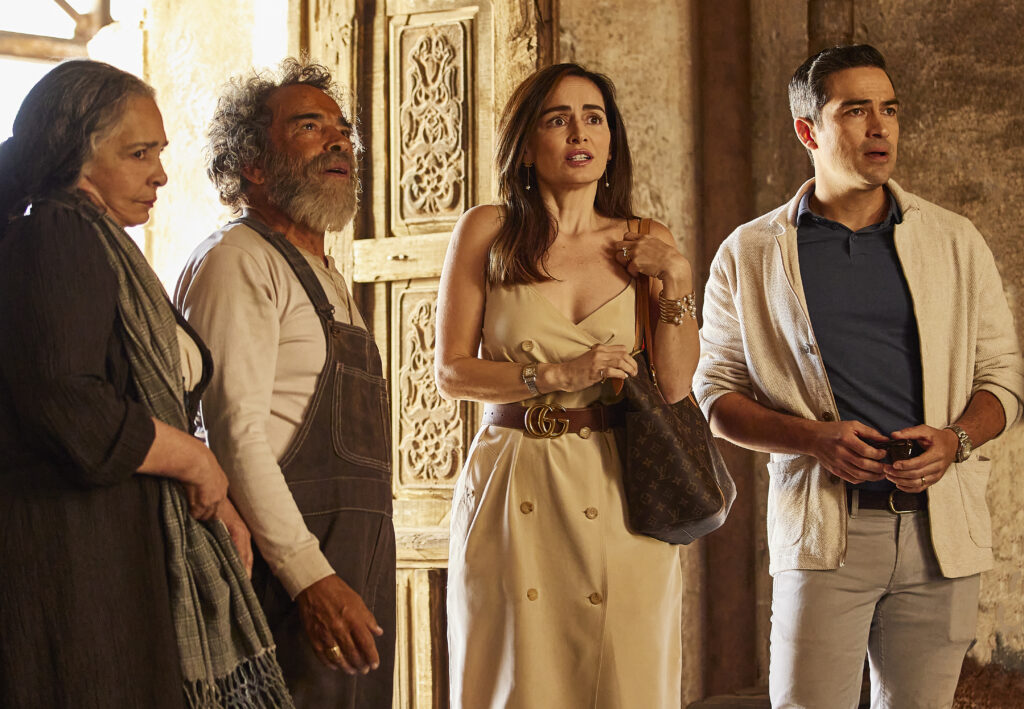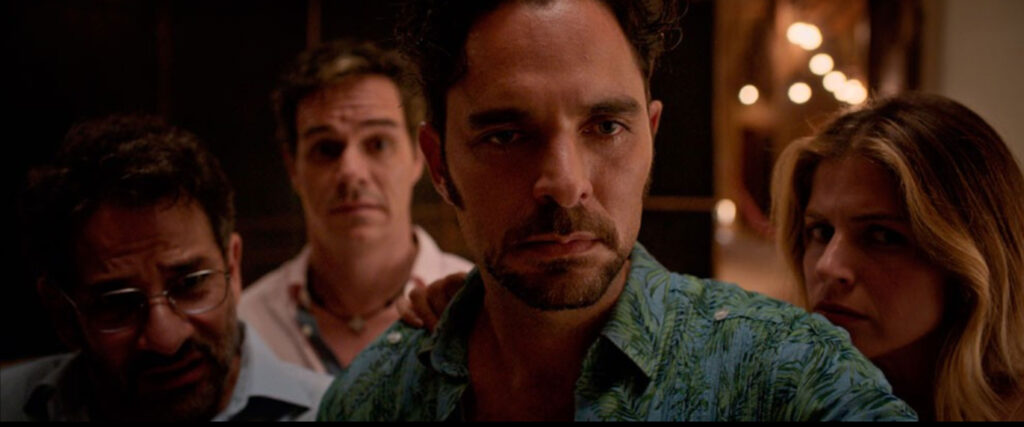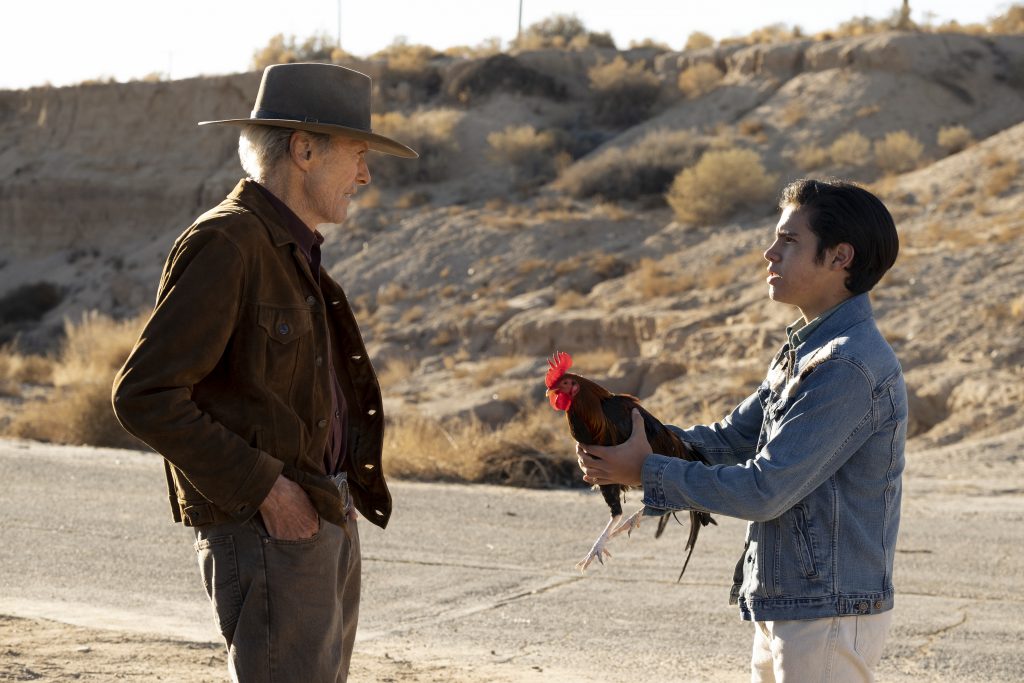October 17, 2023
by Carla Hay

Directed by Roger Ross Williams
Spanish with subtitles
Culture Representation: Taking place in Mexico, from 1988 to 1993, the dramatic film “Cassandro” (based on a true story) features a predominantly Latin cast of characters (with some white people) representing the working-class, middle-class and wealthy.
Culture Clash: Openly gay wrestler Saúl Armendáriz changes his name to Cassandro, and he becomes a wrestling star, but he faces challenges inside and outside the ring because of his sexuality.
Culture Audience: “Cassandro” will appeal primarily to people who are fans of star Gael García Bernal and anyone interested in unique stories about wrestlers.

The dramatic film “Cassandro” isn’t a comprehensive biopic because it only focuses on a period time when luchador Cassandro (whose real name is Saúl Armendáriz) had a career that was on the rise. Even though Gael García Bernal doesn’t look like the real Cassandro, he does a pretty good job of embodying his essence. This lucha libre biopic isn’t as interesting as the documentary “Cassandro, the Exotico!,” but it’s a fairly compelling drama.
Directed by Roger Ross Williams (who co-wrote the “Cassandro” screenplay with David Teague) “Cassandro” glosses over or leaves out some things that were in the 2019 documentary “Cassandro, the Exotico!,” which told much more of Cassandro’s life story. The dramatic film “Cassandro” (which had its world premiere at the 2023 Sundance Film Festival) is more like a few chapters in a biography. Bernal’s performance is the main reason to watch, because some of the movie gets repetitive.
The real Cassandro was born and raised in El Paso, Texas. As an adult, he relocated to Mexico, where he made his name as a luchador. His birth year was 1970, and the “Cassandro” movie takes place from 1988 to approximately 1993, when he was in his late teens and early 20s. Bernal was born in 1978, which means that he was in his early 40s when he made “Cassandro” but portraying someone who is supposed to be in his late teens and early 20s. Bernal is also much thinner than the stocky Cassandro, and their faces have no resemblance to each other.
Despite these discrepancies in physical appearance and age, Bernal immerses himself in the character of Cassandro. People who know what the real Cassandro looks like might not be able to get past how different Bernal looks from the real Cassandro. However, for those who can appreciate seeing a wrestling movie with good acting, there’s plenty to like about “Cassandro.”
The movie is told in chronological order and begins in a dressing room before a wrestling match. Cassandro, whose wrestling persona at the time was wearing a mask, is being taunted by the wrestler who will be his opponent in the ring: a brute named Gigántico (played by real-life wrestler Murder Clown), who is nearly twice the size of Cassandro.
“Do you like digging holes, or do you like getting your hole dug?” Gigántico asks Cassandro. Cassandro then places a photo of his mother Yocasta (played by Perla De La Rosa) on his dressing room table. Gigántico then tells Cassandro: “You should take off your mask and become an exotico.” (An exotico is a luchador who dresses in drag or wears heavy makeup un wrestling matches and does exaggerated moves that are meant to depict someone who is a flamboyant gay man.)
Gigántico continues to needle Cassandro: “What’s with the shitty moustache?” Cassandro answers, “I grew it for you, honey. I heard you like the way it tickles.” Cassandro loses the match against Gigántico. And then, Cassandro is even more disappointed when he hears he has to fight Gigántico again in Cassandro’s next match.
At the time, Cassandro is on the low end of the professional wrestling hierarchy. Like most athletes, he wants to become a champion. As luck would have it, Cassandro finds the trainer he needs. She’s a wrestler named Sabrina (played by Roberta Colindrez), who uses the wrestler name Lady Anarquía.
Sabrina has been observing Cassandro for a while and has become an admirer who thinks Cassandro has a lot of potential. When she offers to train Cassandro, he tells her he won’t be able to afford what she charges. Sabrina replies, “Don’t worry about it.”
Saúl/Cassandro is very close to his mother Yocasta and is unapologetic about being a “mama’s boy.” Yocasta, who works as a housekeeper/maid, is accepting of Saúl/Cassandro being openly gay. The movie shows that Yocasta gets some prejudice from two maid co-workers who make derogatory remarks about Yocasta being a single mother of an illegitimate son.
Saúl/Cassandro is estranged from his religious father Eduardo (played by Robert Salas), who does not accept Saúl/Cassandro being gay. Saúl/Cassandro and Eduardo have not seen each other since Saúl/Cassandro came out as gay when he was 15 years old. Eduardo and Saúl/Cassandro later have a conversation, which is one of the best scenes in the movie.
The movie alternates between showing Cassandro’s rise as an exotico in the lucha libre circuit and showing things that happen in his personal life. He starts using cocaine with a drug buddy named Felipe (played by Benito Antonio Martínez Ocasio, also known as music star Bad Bunny), who seems to be sexually attracted to Cassandro, but Felipe (who has a girlfriend) presents himself to the world as being heterosexual.
Cassandro has a more emotional connection to a fellow wrestler named Gerardo (played by Raúl Castillo), who is married to a woman and has two underage kids with her. Cassandro briefly met Gerardo’s wife and kids when he and Yocasta were at a diner and happened to see Gerado and his family at a nearby table. Soon after Cassandro and Gerardo meet each other, they have a secretive romance. But considering that Gerardo is deeply closeted and has no intention of leaving his wife, it’s easy to predict what will happen to the affair that he’s having with Cassandro.
“Cassandro” shows glimpses of the business wheeling and dealing that takes place in lucha libra industry. Cassandro’s agent/booker is Lorenzo (played by Joaquín Cosío), who introduced Felipe to Cassandro. Lorenzo’s ethics are very murky, since he knows and almost encourages Felipe to supply Cassandro with cocaine. Cassandro experiences a lot of homophobia from people in the wrestling industry and in the general public, but Lorenzo doesn’t seem to care too much, as long as Cassandro is making money for Lorenzo.
Because “Cassandro” takes place over an approximate five-year period, which consists of Cassandro’s earliest years as a pro wrestler, it’s not depicted in the movie how Cassandro’s cocaine addiction escalates and nearly ruins his life and career. This part of Cassandro’s life story is in “Cassandro the Exotico!” documentary. Perhaps the filmmakers of “Cassandro” didn’t want to do a typical “rise-fall-comeback” story arc that is often used in celebrity biopics, but it still feels like the movie doesn’t have a realistic portrayal of the down sides of Cassandro’s cocaine addiction.
“Cassandro” has some areas that come across as a bit dull and too talkative. The wrestling scenes are entertaining, but the movie’s most emotionally resonant moments happen outside the ring. The mother/son relationship that Cassandro and Yocasta have is enjoyable to watch. However, the character of Sabrina seems underdeveloped in the movie, which makes her dialogue quite generic. Even when the movie has some weak moments of banality, Bernal carries the movie with emotional authenticity and charisma.
Amazon Studios released “Cassandro” in select U.S. cinemas on September 15, 2023. Prime Video premiered the movie on September 22, 2023.


















